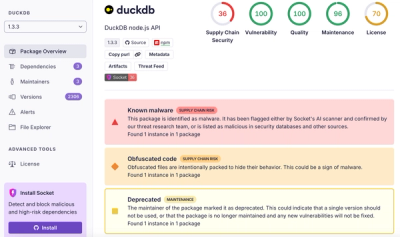
Product
Introducing Tier 1 Reachability: Precision CVE Triage for Enterprise Teams
Socket’s new Tier 1 Reachability filters out up to 80% of irrelevant CVEs, so security teams can focus on the vulnerabilities that matter.
@adamvr/mongration
Advanced tools

A node.js migration framework for MongoDB.
This is a javascript framework that connects to a mongoDB and run the migrations following the specified order. It is very different from other migration projects because of:
Table of Contents
It's a regular node module, just npm install and require it:
npm install mongration --save
var Migration = require('mongration').Migration;
The configuration object is a straightforward javascript object that contains the MongoDb access and the collection that will be used to save the migration state:
module.exports = {
hosts: 'my.host.com:27017',
db: 'mydb',
user : 'myuser',
password : 'mypass',
mongoUri : 'mongodb://myuser:mypass@my.host.com:27017/mydb',
migrationCollection: 'migrationversion'
}
The migrationCollection configuration is always required. This is the collection name where the migration state is persisted.
You can either specifiy connection parameters separately, or the entire mongoUri with all the connection parameters. If you decide to go with the splitted params, hosts parameter is required.
Please use user and password params only when authentication is required.
Migration objectSimply require mongration constructor and initialize it with your configuration:
var mydbConfig = require('./config');
var Migration = require('mongration').Migration;
var mydbMigration = new Migration(mydbConfig);
A migration step is a regular javascript object which has 3 properties:
id — Migration step ID must be unique (required): Will be used to save migration state on databaseup — Migration script itself (required): Uses MongoDB native driver to run commands on databasedown — Rollback script itself (optional): Will be used to Rollback changes in case migration has any errormodule.exports = {
id: '1-step',
up : function(db, cb){
db.collection('testcollection').insert({ name: 'initial-setup' }, cb);
},
down : function(db, cb){
db.collection('testcollection').remove({ name: 'initial-setup' }, cb);
}
}
Both up and down receive two parameters: db (MongoDB connection) and cb (a callback function that will tell the framework that the step has been completed with / out errors).
Migration object exposes an add method which receives both single or bulk migration steps. You must provide the migration file path to this framework so it can read it and run checksum security routine.
We suggest nodejs path module to discover migration step absolute path:
var path = require('path');
// adding bulk
mydbMigration.add([
path.join(__dirname, './migrations-folder/1-step.js'),
path.join(__dirname, './migrations-folder/2-step.js')
]);
// adding single
mydbMigration.add(path.join(__dirname, './migrations-folder/3-step.js'));
This framework supports multiple queries within the same migration step — developer just needs to handle local callbacks (between queries) and call framework back whenever the whole step is done.
We strongly suggest you to use async module to handle asynchronous javascript. Multiple queries example:
var async = require('async');
module.exports = {
id: 'my-migration-step-with-multiple-commands',
up : function(db, cb){
async.series(
[
function(_cb){db.collection('testcollection').insert({ name: 'initial-setup' }, _cb)},
function(_cb){db.collection('othercollection').insert({ name: 'second-setup' }, _cb)},
function(_cb){db.collection('othercollection').insert({ name: 'third-setup' }, _cb)}
],
cb
);
}
}
After adding all steps to your migration, you simply need to run it like:
mydbMigration.migrate(function(err, results){});
The migrate callback function receives 2 parameters:
err — Error message (if the migration did not run properly)results — A list of status for each migration step. See more on Migration outputs.For a complete example, check samples folder.
All migration steps will have an output so developers know how exactly their migrations were performed.
The migration step was successfully performed in the database. This step is saved in the database.
The migration step was skipped because it was already performed in a previous migration. This step was already saved in the database.
The migration step returned an error and the rollback process was called. The error details are returned on migration.migrate() callback as described in Running migrations. This step was not saved in the database.
Although the migration step was successfully performed, the rollback process was called due to an error in a step after this one. This step is not saved in the database.
An error happened during migration process and this step rollback process was not successfully completed. The error details are returned on migration.migrate() callback as described in Running migrations. This step was not saved in the database - however database may contain unexpected data since rollback was not completely done.
The migration step was not processed because an error happened before getting into this step. This step is not saved in the database.
Read the CLI tool docs.
This framework was built focused on solving real problems. For that, we have already included the features below.
Whenever a migration step is successfully performed, the step file checksum is saved on the database. Checksum is the sum of all step file characters.
Example: If migration step 1-changed-step-sample was succesfully run, then a developer changes any part of it and try to run it again, the migration step will have **status : error ** and the exception below will be triggered:
"[1-changed-step-sample] was already migrated in a different version. Current version[0685c17d538741a062c488ea776b0576] - Database version[72d9204bee94542118bd99cdde8edc0f]"
It makes sure that previsouly ran migrations will be rerun on the same order and, if developers changed the migration order, the migration step will have **status : error ** and the exception below will be triggered:
"[1-step-sample] was already migrated on [Sat Dec 19 2015 10:18:27 GMT-0200 (BRST)] in a different order. Database order[1] - Current migration on this order[1-reordered-step-sample]"
The migration state is saved on the migrationCollection defined on configuration:
db.migrationversion.find()
{ "id" : "1-simple-query-sample", "checksum" : "a10e3030bb9683a971bae1f95b986033", order : "0", "date" : ISODate("2015-12-18T14:28:38.149Z") }
{ "id" : "2-multi-parallel-query", "checksum" : "3999fbcdf95d4c4a06e839cd0c66ede5", order : "1", "date" : ISODate("2015-12-18T14:28:38.187Z") }
{ "id" : "3-multi-sequential-query", "checksum" : "1181db9b787251df92fd9fb676da2d76", order : "2", "date" : ISODate("2015-12-18T14:28:38.287Z") }
The framework automatically saves the following data as migration state:
id — ID defined on each migration stepchecksum — Checksum of migration step file that will be used to compare as part of future migrationsorder — Order the step was rundate — When the migration step was processedAs describred above, this framework supports migrations on both MongoDB standalone and replica sets versions. To connect to a replica set, enter your replicaSet name and add the replica set hosts on your Configuration:
module.exports = {
//...
// with splitted params
hosts: 'my.host.com:27017,my.otherhost.com:27018,my.backuphost.com:27019',
replicaSet : 'myreplica',
// or complete connection string
mongoUri: 'mongodb://my.host.com:27017,my.otherhost.com:27018,my.backuphost.com:27019/mydb?replicaSet=myreplica'
}
Whenever an error happens during a migration step, the rollback process is automatically called.
The rollback process basically consists in calling down method of every step that was previously marked as ok or error - in other words: Skipped (previously ran steps) migration steps are not rolled back.
Please consider that steps without down methods will be automatically skipped when rollback process is called.
Please check Migration outputs to understand how rollback modifies steps' statuses.
Developers can run multiple queries (sync or async) as part of the same migration step.
Please see below an example on how to run multiple synchronous queries as part of one migration step:
var async = require('async');
module.exports = {
id: 'sequential-query',
up : function(db, cb){
async.series(
[
function(cb){db.collection('testcollection').insert({ name: 'initial-sequential-setup' }, cb)},
function(cb){db.collection('testcollection').insert({ name: 'second-sequential-setup' }, cb)},
function(cb){db.collection('testcollection').insert({ name: 'third-sequential-setup' }, cb)}
],
cb
);
}
}
Please see below an example on how to run multiple asynchronous queries as part of one migration step:
var async = require('async');
module.exports = {
id: 'parallel-query',
up : function(db, cb){
async.parallel(
[
function(cb){db.collection('testcollection').insert({ name: 'initial-parallel-setup' }, cb)},
function(cb){db.collection('testcollection').insert({ name: 'second-parallel-setup' }, cb)},
function(cb){db.collection('testcollection').insert({ name: 'third-parallel-setup' }, cb)}
],
cb
);
}
}
You have the ability to run migrations in more than one database at the same time. Please check the Multi DB samples.
The MIT License (MIT)
Copyright (c) 2015 Andre Eberhardt
Permission is hereby granted, free of charge, to any person obtaining a copy of this software and associated documentation files (the "Software"), to deal in the Software without restriction, including without limitation the rights to use, copy, modify, merge, publish, distribute, sublicense, and/or sell copies of the Software, and to permit persons to whom the Software is furnished to do so, subject to the following conditions:
The above copyright notice and this permission notice shall be included in all copies or substantial portions of the Software.
THE SOFTWARE IS PROVIDED "AS IS", WITHOUT WARRANTY OF ANY KIND, EXPRESS OR IMPLIED, INCLUDING BUT NOT LIMITED TO THE WARRANTIES OF MERCHANTABILITY, FITNESS FOR A PARTICULAR PURPOSE AND NONINFRINGEMENT. IN NO EVENT SHALL THE AUTHORS OR COPYRIGHT HOLDERS BE LIABLE FOR ANY CLAIM, DAMAGES OR OTHER LIABILITY, WHETHER IN AN ACTION OF CONTRACT, TORT OR OTHERWISE, ARISING FROM, OUT OF OR IN CONNECTION WITH THE SOFTWARE OR THE USE OR OTHER DEALINGS IN THE SOFTWARE.
FAQs
Node.js mongodb migration framework
We found that @adamvr/mongration demonstrated a not healthy version release cadence and project activity because the last version was released a year ago. It has 1 open source maintainer collaborating on the project.
Did you know?

Socket for GitHub automatically highlights issues in each pull request and monitors the health of all your open source dependencies. Discover the contents of your packages and block harmful activity before you install or update your dependencies.

Product
Socket’s new Tier 1 Reachability filters out up to 80% of irrelevant CVEs, so security teams can focus on the vulnerabilities that matter.

Research
/Security News
Ongoing npm supply chain attack spreads to DuckDB: multiple packages compromised with the same wallet-drainer malware.

Security News
The MCP Steering Committee has launched the official MCP Registry in preview, a central hub for discovering and publishing MCP servers.